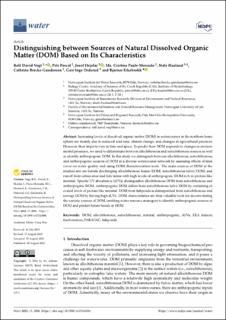| dc.contributor.author | Vogt, Rolf David | |
| dc.contributor.author | Porcal, Petr | |
| dc.contributor.author | Hejzlar, Josef | |
| dc.contributor.author | Paule‐Mercado, Ma. Cristina | |
| dc.contributor.author | Haaland, Ståle Leif | |
| dc.contributor.author | Gundersen, Cathrine Brecke | |
| dc.contributor.author | Orderud, Geir Inge | |
| dc.contributor.author | Eikebrokk, Bjørnar | |
| dc.date.accessioned | 2023-08-22T09:05:17Z | |
| dc.date.available | 2023-08-22T09:05:17Z | |
| dc.date.created | 2023-08-20T16:21:46Z | |
| dc.date.issued | 2023 | |
| dc.identifier.citation | Water. 15 (16), 3006. | en_US |
| dc.identifier.issn | 2073-4441 | |
| dc.identifier.uri | https://hdl.handle.net/11250/3085171 | |
| dc.description.abstract | Increasing levels of dissolved organic matter (DOM) in watercourses in the northern hemisphere are mainly due to reduced acid rain, climate change, and changes in agricultural practices. However, their impacts vary in time and space. To predict how DOM responds to changes in environmental pressures, we need to differentiate between allochthonous and autochthonous sources as well as identify anthropogenic DOM. In this study we distinguish between allochthonous, autochthonous, and anthropogenic sources of DOM in a diverse watercourse network by assessing effects of land cover on water quality and using DOM characterization tools. The main sources of DOM at the studied site are forests discharging allochthonous humic DOM, autochthonous fulvic DOM, and runoff from urban sites and fish farms with high levels of anthropogenic DOM rich in protein‐like material. Specific UV absorbency (sUVa) distinguishes allochthonous DOM from autochthonous and anthropogenic DOM. Anthropogenic DOM differs from autochthonous fulvic DOM by containing elevated levels of protein‐like material. DOM from fishponds is distinguished from autochthonous and sewage DOM by having high sUVa. DOM characteristics are thus valuable tools for deconvoluting the various sources of DOM, enabling water resource managers to identify anthropogenic sources of DOM and predict future trends in DOM | en_US |
| dc.description.abstract | Distinguishing between Sources of Natural Dissolved Organic Matter (DOM) Based on Its Characteristics | en_US |
| dc.language.iso | eng | en_US |
| dc.publisher | MDPI | en_US |
| dc.rights | Navngivelse 4.0 Internasjonal | * |
| dc.rights.uri | http://creativecommons.org/licenses/by/4.0/deed.no | * |
| dc.subject | Biogeokjemi | en_US |
| dc.subject | Biogeokjemi | en_US |
| dc.title | Distinguishing between Sources of Natural Dissolved Organic Matter (DOM) Based on Its Characteristics | en_US |
| dc.type | Peer reviewed | en_US |
| dc.type | Journal article | en_US |
| dc.description.version | publishedVersion | en_US |
| dc.rights.holder | © 2023 The Authors | en_US |
| dc.subject.nsi | VDP::Miljøkjemi, naturmiljøkjemi: 446 | en_US |
| dc.subject.nsi | VDP::Environmental chemistry, natural environmental chemistry: 446 | en_US |
| dc.source.pagenumber | 27 | en_US |
| dc.source.volume | 15 | en_US |
| dc.source.journal | Water | en_US |
| dc.source.issue | 16 | en_US |
| dc.identifier.doi | 10.3390/w15163006 | |
| dc.identifier.cristin | 2168202 | |
| dc.relation.project | The EEA and Norway Grants Fund for Regional Cooperation: 2020TO01000202 | en_US |
| dc.source.articlenumber | 3006 | en_US |
| cristin.ispublished | true | |
| cristin.fulltext | original | |
| cristin.qualitycode | 1 | |

